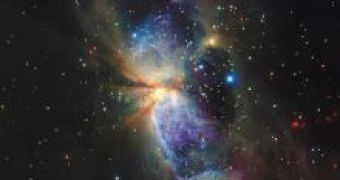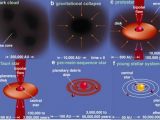New findings from a large survey of galaxies on almost all wavelengths suggest that star formation is largely driven by the supply of raw materials, rather than by galactic mergers that trigger sudden bursts of star formation. Stars form when clouds of gas and dust collapse under the force of gravity, and the study supports a scenario in which exhaustion of a galaxy's gas supply leads to a gradual decline in the star-formation rate.
DEEP (Deep Extragalactic Evolutionary Probe) began about 15 years ago, led by David Koo, professor of astronomy and astrophysics at UCSC, and other UCSC astronomers using the twin 10-meter Keck Telescopes at the W. M. Keck Observatory in Hawaii and NASA's Hubble Space Telescope to conduct a large-scale survey of distant field galaxies. Phase 2 of the project, led by UCSC and UC Berkeley, began three years ago using the powerful DEIMOS spectrograph on the Keck II Telescope and has now gathered spectroscopic data from almost 40,000 distant galaxies.
DEEP2 has observed 13,000 galaxies in the Extended Groth Strip, one of four fields surveyed by the project. The Extended Groth Strip collaboration consists of astronomers from 16 institutions who have pooled their data and resources to create what is now one of the most intensely studied regions of the sky. Joining the DEEP2 team in the Extended Groth Strip Survey is a broad consortium of other survey teams that are contributing with data. Infrared data from NASA's Spitzer Space Telescope enabled astronomers to see through the dust that obscures much of the star formation taking place in distant galaxies. This was especially important for a study conducted by Kai Noeske, a postdoctoral researcher at the University of California, Santa Cruz.
"Having the infrared data from Spitzer allows us to measure the star formation rates very accurately because we are no longer blinded by dust," Koo said. The array of instruments trained on the Extended Groth Strip covers a wide range of wavelengths: x-rays, ultraviolet, visible and infrared light, and radio waves. "This is an exceptional period of time for astronomy, because for the first time we are able to combine data from almost all of the important wavelengths," Koo said.
By analyzing data from a combination of powerful instruments, researchers derived information on galaxy weights and star formation rates, as well as the numbers of stars already formed, for more than 3,500 galaxies. They found that the mass of a galaxy is an important factor determining how fast it makes stars and how the star formation rate evolves over time, said Noeske. "The picture we're getting is that heavy galaxies form stars early and rapidly, whereas smaller galaxies form their stars over longer timescales," stated Noeske.
The study sheds light on ongoing debates over the physical mechanisms that activate star formation in galaxies: in particular, the importance of star bursts triggered by mergers of similar galaxies.
"What we see is consistent with mostly undisturbed galaxies using up their gas over time, like firewood burning down," Noeske said. "We have now been able to track star formation in galaxies out to modest distances, more than half the age of the universe, and we find that all galaxies, big or small, seem to be fading gradually so that they are less active today than they were further back in time," Koo said.
Astronomers have found from previous galaxy surveys that star formation activity becomes more intense as they probe farther back in time. One proposed explanation has been that galaxy mergers were more frequent in the past, triggering bursts of star formation due to compression of gas clouds during the merger process. "We are finding that mergers do not appear to play the dominant role in star formation, because we see normal-looking, undisturbed galaxies that are undergoing large amounts of star formation," Koo said. "There probably are multiple mechanisms that can activate star formation. We are asking which is dominant," he added. "Mergers do drive star formation; they just don't seem to be the major driver."

 14 DAY TRIAL //
14 DAY TRIAL // 
